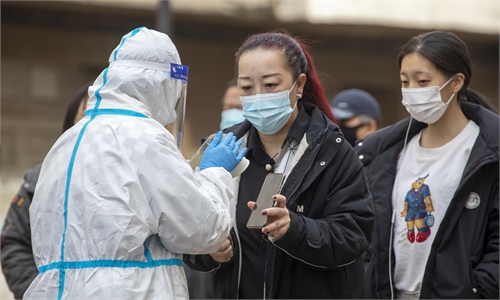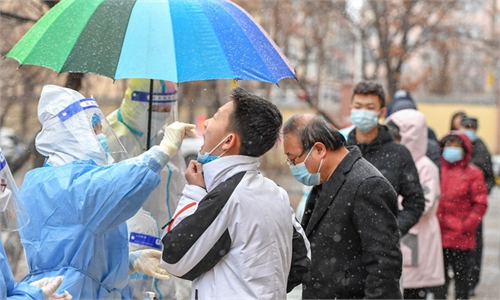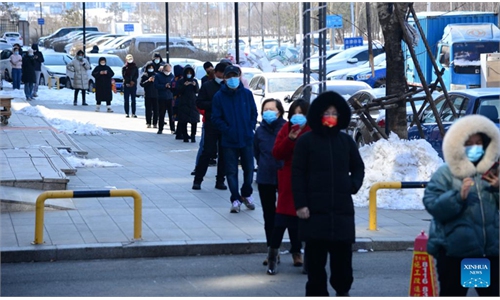
Aerial photo taken on March 20, 2022 shows citizens lining up to take nucleic acid test at a testing site in Changchun, northeast China's Jilin Province. Photo:Xinhua
The health authority of Northeast China's Jilin Province said on Wednesday that the pandemic remains severe and the peak is yet to come. The region has reported daily infections of more than a thousand for 11 days since March 12.
The local government will continue to block community transmission to the greatest extent possible so that the infection turning point can come soon, Zhang Li, vice head of Jilin's provincial health authority, said at a press conference on Wednesday.
Zhang said the recent surge in daily COVID-19 cases partly reflects the effective work in detecting hidden positive cases and quarantining close contacts. The province reported 2,320 confirmed COVID-19 cases and 528 silent virus carriers on Tuesday, mainly in the capital city of Changchun and Jilin city.
Zhang said the pandemic has hit nine cities in the province, with patients over 60 years old accounting for 34 percent of all confirmed cases.
Chinese Vice Premier Sun Chunlan said on Tuesday that the province still has a long way to go before achieving the target of zero COVID-19, given the current circumstances.
Sun called for the local government to be vigilant in the new round of nucleic acid testing, and not to forget to test people at construction sites or hotels.
Sun also called for rapid reactions in transferring and quarantining close contacts, as well as guaranteeing the supply of daily necessities for local residents.
Zhao Qinglong, director of the emergency department of the Centers for Disease Control in Jilin Province, said there were several factors that led to the sharp increase in the province's daily reported cases, People's Daily reported on Thursday.
Zhao said the first reason is that the recent COVID-19 flare-up was triggered by an easily transmissible sub-variant of Omicron, called BA.2, which can infect people with no symptoms.
The epidemiological investigation has shown that the virus entered Jilin Province in late February, but the community transmission had already begun by the time it was detected, said Zhao, noting that the outbreak started in rural districts where people often have group meals and gatherings such as attending funerals.
Zhao said the mass movement of people after Spring Festival and students going back to schools also sped up the transmission, and the recent surge in positive cases was also partly down to hidden cases being detected by rounds of mass nucleic acid testing.



